|
|
Marco

|
|
 |
|
|
Marco was a good race horse -- many considered him the best of his generation at age three, despite his not contesting the classics -- but his principal significance in thoroughbred history is his link in the Godolphin Arabian sire line chain. In addition to being the grandsire, in sire descent, of the undefeated Hurry On and of the great steeplechase sire, My Prince, he was dam's sire of another top steeplechase sire, Cottage, and of the mare Sweet Lavender, from whom Ambiorix, Klairon, My Babu and other good horses descend. |
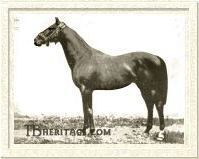
Marco's sire, the undefeated Barcaldine
| | Marco's sire was the unbeaten Barcaldine (1878), whose career was occluded by the actions of his owner, and who was not, many said, "ever really extended." At age two, his wins included the Railway Stakes, the National Produce Stakes, the Beresford Stakes and the Paget Stakes, the latter three held on successive days at the Curragh. At age three he again won three races on successive days at the Curragh, at two and three miles; he walked over in the third race. He also won the 1-1/2 mile Baldoyle Derby, but failed to run in any other races due to his owner's betting unsuccessful betting strategies. |
Likewise, at age four, he did not run, again due to his owner's manipulations, which caused Barcaldine to be struck from the Cesarewitch and the Cambrdigeshire. Sold in 1882, the next year he won four races: the 1-1/2 mile Westminster Cup, the 1-1/2 mile Epsom Stakes, the 3 mile Orange Cup and the Northumberland Plate.
Barcaldine got winners of 305 races in England, including Oaks and 1,000 Guineas winner Mimi and Derby and St. Leger winner Sir Visto. His son Espoir (1889) won the German Derby and Hugarian St. Leger, and he got a number of other winners, mostly stayers. His daughters became good broodmares, among them the dams of the great French runner Perth, the influential Argentinian sire Oran, the five-time leading Australian sire Malster, and the good French runner MacDonald II. Some of his sons got good winners of distance races, and Wolf's Crag, a winner of the Lincolnshire Handicap, got Linacre, who became a leading sire in Australia.
Marco's dam, Novitiate (1882), was by Derby winner and seven-time leading sire, Hermit. Her dam, Retty, had won nine races, and among Retty's produce was the Doncaster Cup winner, Rama. Novitiate was raced by Sir Blundell Maple five times as a juvenile, winning a maiden plate at Epsom, and nothing else. Retired to the stud, she first produced Rokeby in 1886, a winner of nine races. She had two fillies next, one of whom, White Veil, later bred four winners, and then she bred Probation, who later won four races.
In 1890 Novitiate and her colt at foot, Young Chieftan (1890, by Highland Chief), were placed in the July sales and purchased for 1,600 guineas by Francis Luscombe, an enthusiastic sportsman who owned Forest House and Tilgate Forest Stud near Crawley in Sussex. Noviate was sent back to Highland Chief that year, but failed to conceive. She was then sent to Barcaldine, then standing at Park Paddocks in Newmarket, and the result was Marco, born in 1892. Her next foal, also to Barcaldine, was a colt that broke its leg as a yearling. Next, she bred a colt by St. Serf, followed by Zuleika (1895), by Sheen, whose distant descendant, Gay Hussard, was a classic winner in Chile. A St. Serf filly, Saint Clare, was Novitiate's next foal, in 1896; she and Noviate were both sold by Luscombe in the December sales; Noviate was re-purchased by her former owner, Maple, and Saint Clare sold to J. Reid Walker. Noviate produced one more foal, Glazier (by Isinglass), before dying.
Marco was sent to the July yearling sales in 1893 with a reserve of 300 guineas. He was unsold, and returned to Luscombe, who formed a partnership with Mr. C. Atherton Brown on the colt's ownership, Brown retaining the right to supervise his training. Marco was sent to trainer Tom Chaloner, maturing into a handsome 2 year old, who looked more like his dam's sire, Hermit, than he did Barcaldine. Before he ran, the Luscombe-Brown partnership dissolved, and Luscombe obtained complete ownership of him again.
Marco on the Turf
Despite his modest record on the turf, Marco was described by two jockeys that rode him identically, as "...the pluckiest devil I was ever on." He never required whip or spur during his races. He was a good feeder, but required little work to stay in shape. He did better in each of his four seasons racing towards the end of the season, what was called an "autumn horse." Despite not contesting the classics -- his nomination had been voided by Brown -- he was considered the best three year old of his generation: that year he beat Telescope in the Lewes Handicap by five lengths, giving him 8 pounds, and a month later Telescope beat Derby winner (and Barcaldine son) Sir Visto by three-quarters of a length in the Doncaster St. Leger, which was enough to convince many the best colt of 1895 was Marco.
He started his juvenile year with a win over 5-1/2 furlongs in the Southport Stakes at Liverpool. He ran second to Telescope, receiving 14 lbs, in the Liverpool Joliffe Stakes, and then third to Whittier and Keelson in York's Convivial Produce Stakes. He sharpened up in the fall, winning the 5-1/2 furlong Triennial at Newmarket, and his next and final race of the season, the 5 furlong Kennett Plate at Newmarket, beating the three year olds Dandy and Grey Leg, and the four year old Milford.
Luscombe took on another partnership on Marco after his juvenile year, with an R.O. Harrild of Bedale, and this joint-ownership continued until Marco retired to stud, when Luscombe bought out his associate.
At age three, Marco ran third in the one mile March Stakes, but six weeks later, in the Payne Stakes, carrying the heaviest weight at 127 pounds, he won at the same distance. In his next race, the Biennial at Ascot, over 5-1/2 furlongs, he ran third. After a two month rest came the 12 (1-1/2 miles) furlong Lewes Handicap. His trainer had protested his entry in this race, saying he wasn't yet fit for the distance, but Luscombe insisted Marco run, and despite his hard blowing in the last furlong, he refused to quit, beating Bed Light by a head, and the future St. Leger winner, Telescope, who was receiving 8 pounds from Marco, by 5 lengths. He then won the 10 furlong Triennial at Newmarket, carrying 131 pounds. His next race, and win, was the Cambridgeshire at Newmarket, beating the five year old Best Man by three lengths, and Count Schomberg, who ran third.
His four year old year was not a success: he won one of his six starts, the 2 mile Triennial at Newmarket in the fall, carrying 131 pounds, thus completing a sweep of the series. He ran second once, in the 10 furlong Champion Stakes at Newmarket, which was won by Labrador, but in this race he beat the Derby winner Sir Visto by three lengths. He was unplaced in the Manchester Cup at 14 furlongs, giving away 18 pounds or more to his opponents; in the Peveril of the Peak Handicap at Derby over 8 furlongs, again carrying top weight of 131 pounds, he also went uplaced, the heaviest weight of the first three runners was 107 pounds. He did not place in the Cambridgeshire that year, nor in the Derby Cup of 8 furlongs, again carrying top weight.
Marco ran five times in his final season at age five. He ran second to Eager in the 8 furlong Rous Memorial, carrying ten pounds over his nearest opponent. He went on to win the Nottinghamshire Handicap over a mile, again at top weight. He ran unplaced in the mile Duke of York Handicap at Kempton, and then third and last in the Limekiln Stakes over a mile. His final race was the Derby Cup again, where he was lightly weighted with 105 pounds, and he failed to place, a poor end to his career.
Marco at Stud
Marco entered the stud in 1898 at a fee of £40. With the exception of two years at Egerton House Stud in Newmarket, he spent his entire career at Luscombe's Tilgate Forest Stud, where he had been raised. He had two winners of four races in his first crop, of 1901, and only a few more the following year, his stud fee dropping to 25 guineas. After that, the number of his winners climbed steadily, as did his stud fee, and by 1909, when he was fourth in the sires lists to Cyllene, Bay Ronald and Gallinule, with 20 winners of 37 races, his book was filled at a fee of 150 guineas. In 1910, the year his top colts of 1907 -- Bronzino and Neil Gow -- recorded their big wins, he placed third in the sire's lists to Cyllene and St. Frusquin, the highest ranking he ever achieved. In all, he got 113 winners of flat races in England, and over a dozen that won over fences, including the 1927 Grand National winner, Sprig, a foal from Marco's last crop of 1917. His most important contribution to the breed was his son, Marcovil, who, although far from his sire's best on the turf, was the one to hand on the Godolphin Arabian sire line through his great undefeated son, Hurry On, and who made great contributions to steeplechasing through another son, My Prince.
In the stud Marco was as erratic, temperamentally, as he had been as a racehorse, and his groom, James Kent, always "played up to Marco when he was moody," and the stud manager at Tilgate Forest Stud "thoroughly understood his idiosyncracies and made allowance for them." Always courageous on the turf, in the stud he developed a touch of hypochondria, making "the most he could of trifling hurts and again and again deceived his attendants into the belief that there was something seriously amiss." One story had him kicked by a mare, and being led back to his stall with "some difficulty," standing in it the "picture of misery," convincing all he had a fractured leg, but no injury could be found. Concluding he was, as he had before, faking it, a mare was brought to the door of his stall, and he "rushed out of the box and showed not the slightest trace of lameness until he returned, when the foxing was repeated."
The old "character" was destroyed at Tilgate Forest Stud in November of 1917, age 25.
|
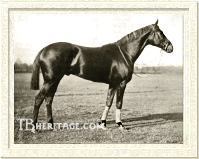
Marcovil had a "dickey" tendon that affected his success
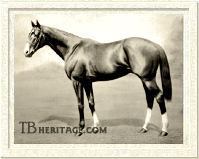
Neil Gow, broke down early
| |
MARCOVIL, was the Marco son who carried on the sire line. He was born in 1903 out of Lady Villikins, who had a good race record under National Hunt rules, both on the flat and over fences. Her dam, Dinah, was three-quarters sister to the great jumper sire Ascetic, and so Lady Villikins had multiple lines to Melbourne. She passed through several hands before producing her third foal, Marcovil, for the Duke of Devonshire at Polegate. In terms of races won, Marcovil was well down in the list of Marco's winners -- around number fourteen, plagued as he was by a tendon injury at age two. When the Duke died in 1908, Luscombe purchased Marcovil at auction, and sent him out for his only really big win, the Cambridgeshire Stakes at 9 furlongs, in the fall of his five year old year, after which he was retired to stud. He mostly stood at Egerton House, Newmarket, but did spend two years alongside his sire at Tilgate Forest Stud. He had a significant impact at stud with his undefeated son, HURRY ON, who sent the sire line forward with seven classic winners and four good sire sons, and with MY PRINCE, who sired three Grand National winners and numerous other jumpers, including the great Easter Hero. Marcovil died unexpectedly in February of 1917, preceding his sire in death by nine months.
NEIL GOW was bred by Archibald Philip Primrose, fifth Earl of Rosebery, and was born in 1907 at the earl's Mentmore Stud. His dam was the great producer Chelandry (1894), by Goldfinch. She had won five races, worth £13,183, including the 1,000 Guineas and the Woodcote Stakes, and placed second in the Oaks.
|
Chelandry's sixteen sons and daughters (born in succession, without a break) won races totaling £38,290, including Skyscraper, Traquair, Popinjay, and Chelys. Her only classic winner was Marco's son, the big, powerful, flashy chestnut colt Neil Gow.
At age two he won the National Breeders' Produce Stakes, as had his mother, the Prince of Wales's Stakes at Goodwood, the Champagne Stakes at Doncaster, and the Imperial Produce Stakes at Kempton. In the latter race, where the going was very heavy, he started out running in the wrong direction, and by the time his jockey had him turned around, his two other opponents were a furlong ahead; in a thrilling exhibit of courage and strength, he gained on them to win by a head.
He started his three year old year by winning the 2,000 Guineas in another exciting race, in which he and Lemberg battled head-to-head for two furlongs, with the victory going to Neil Gow by a short head. He came out of that race with a sore hock, and did not run well in the Derby, with its downhill run to Tattenham Corner, finishing fourth to Lemberg's first. Seven weeks later he met Lemberg again in the Eclipse Stakes, and this time the two ran a dead heat. Neil Gow broke down a few weeks later, and began his stud career in 1911. In all, he had won seven of his ten starts. He was not a particularly successful sire: British Empire, an influential sire in Argentina, and twice leading sire there, was descended from him via a daughter, PERCE-NIEGE. Another daughter, HERSELF, produced Oaks and Jockey Club Stakes winner Chatelaine (by Phalaris).
Of Marco's other sons, BEPPO, bred in 1903 by Luscombe, out of the St. Frusquin mare, Pitti, won some good races for James de Rothschild. He was a bit below top class, but completely genuine and courageous, and a good stayer. He won two races at age two, and at age three he won the Union Jack Stakes, the Jockey Club Stakes, and was beaten by two short heads in the St. Leger by Troutbeck and Prince William. He ran fourth in the 2,000 Guineas, following interference, and sixth in the Derby. At four, he won the Manchester Cup, carrying top weight, and the Hardwicke Stakes at Ascot, and was second to The White Knight in the Ascot Cup. He broke down running in the Prix du President de la Republique in France. In all, he won £13,860, and six races.
Beppo was retired to Glasgow Stud at Enfield, where it was hoped he would assist in reviving the Godolphin Arabian sire line, but it was not to be; in twenty years at stud he sired winners of less than £60,000. Beppo's best was Picaroon (1922, from Cicero daughter Cieronnetta), an unbeaten juvenile that was sidelined by lymphangitis after his first win at the Craven Meeting at Newmarket in the spring of his three year old year; he ran fourth in the Doncaster St. Leger to Solario, and then won four races in a row, including the Champion Stakes. His leg problems returned and worsened, and he was destroyed in the spring of 1927, terminating that promising avenue of continuance. Beppo's only classic winner was the filly My Dear (1915), who won the Oaks. His best producing daughter was Gay Laura, dam of Gay Crusader (1914), who won the war-time English Triple Crown. Beppo died in 1929 at Heath Stud, Newmarket. A Beppo daughter, Blue Paper, was second dam of Russian Hero (1940), who won the 1949 Grand National.
Another Marco son, SANSOVINO (not the horse of the same name by Swynford), also bred and owned by Luscombe, won the Lincolnshire Handicap in 1905 and six races in his turf career, but died early without leaving any youngsters of merit.
Two Marco sons were purchased to Australia BRONZINO and VARCO. VARCO (1907), was a moderate winner in the U.K. but was pretty successful in the antipodes, getting a number of stakes winners, including Manna (1916, AJC Gimcrack and December Stakes), and Balboa (NZ, 1911), winner of the WRC New Zealand St. Leger and other good races, and sire of a great many good handicappers in New Zealand.
|
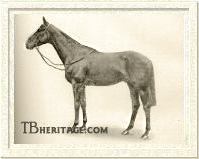
Doncaster Cup winner Bronzino went to Australia
| | BRONZINO (1907, from Flitters), was a golden chestnut with the Marco blaze, but no white legs. Bred by Luscombe and sold to James de Rothschild, he started first at age three, winning the Newbury Spring Meeting's Greenham Stakes of £879.
He failed to place in the 2,000 Guineas, but Luscombe thought he had a shot at the Grand Prix de Paris, and shipped him there, where he ran third to Nuage and Reinhart, beating Derby winner Lemberg. Back in England in the fall, he ran second to Swynford, by a head, in the Doncaster St. Leger, with Lemberg third; this was the fastest St. Leger to that time. Two days later he won the Doncaster Cup, beating Bachelor's Double. He ran fourth in the Cesarewitch, having bruised his heel four days before the race.
|
| At age four he was third in the City and Suburban and second in the Derby Gold Cup. The next season he ran second for the Manchester Cup, conceding the winner, Donnithorne, 38 pounds! He broke down during preparation for the Ascot Gold Cup, and was retired. He was purchased in July of 1912 by Samuel Hordern of Sydney, who owned Wilton Park stud, and shipped a month later to begin his stud career in a new country. He sired several stakes winners, including the mare Stitching, winner of the TRC Doncaster Handicap and dam of Distich, who won the same race. |
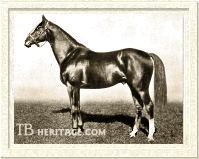
Omar Khayyam, one of the fastest ever imported into the U.S.
| |
The Marco sire line went to America with his golden chestnut son, OMAR KHAYYAM (1914, from Persimmon daughter Lisma), bred by Sir John Robinson and sold as a yearling for $1500 to the American partnership of Billings and Johnson, who shipped him to the U.S.
He was the first foreign-bred horse to win the Kentucky Derby, and, many said, the best and classiest horse ever to have been imported. He was somewhat small, elegant, and refined, but he had the Marco tall socks and wide blaze, blazing speed and good staying power. Although ranked second best after Hourless as the champion colt of 1917, he had won $20,000 more in stakes money, had run many more times, and more consistently, and had beaten Hourless twice by the end of their three year old year.
| |
After the Derby Omar Khayyam was sold to Montreal biscuit manufactuer Wilfrid Viau for $26,000. He ran poorly -- last -- for Viau in the Brooklyn Handicap, after the Derby, then won a race at Jamaica race course, beating Campfire, and followed that with a win over Hourless in the Brooklyn Derby (later the Dwyer Stakes). He swept the big races at Saratoga, including the Kenner and Travers Stakes, and the Saratoga Cup, and went on to beat Hourless again on a fast track in a thrilling Lawrence Realization Stakes race. He followed that win by beating the field in the Havre de Grace Handicap. He was finally beaten by Hourless, by a length, in the McLean Memorial at Laurel Park in October, in which a new track record was set for ten furlongs. With still no rest in sight, the fast and game horse went on to win the Pimlico Autumn handicap, giving away 30 pounds and setting a new track record. He was beaten in his last race of a long season by the inferior Westy Hogan in the Bowie Handicap, giving away ten pounds.
At age four he was burdened with high weights, and could not replicate his three year old form, although he did win two races during the season. In 1919 he won one race and was retired to stud. Trainer Charles Patterson, who had selected Omar Khayyam in England and had managed the speedy Ornament's career, said he was the fastest horse he had ever handled.
Viau put Omar Khayyam in the stud at Claiborne Stud, Kentucky, in 1920; Viau died soon thereafter, and his wife, Lousie, carried on the bloodstock operation until 1926, when she sold her broodmares in Lexington. In 1929 she moved Omar Khayyam to the J.P. Jones stud in Charlottesville, Virginia, where he stood until his death in September,1938, at the age of 24. He was moderately successful at stud, placing 14th on the leading sire's list (amounts won) in 1924, sixth in 1925, 13th in 1926, 16th in 1927, 13th in 1928, 7th in 1929, and after that appearing twice more in 18th place before falling off it. He was a remarkably consistent sire, and despite the ranking based on amounts won, he was often in the upper ten in number of first place winners of races. He was unable to get a good sire son: Aga Khan (1921) won 12 races and $88,000, but got nothing of note; likewise, Mr. Khayyam, who won the Wood Memorial and two other good races at age 2, and the Metropolitan and Champlain Handicaps at age 4. The black Balko (1925) won 22 races in his 63 starts, including the Baltimore Handicap and the Toboggan Handicap, but he also failed to leave a sire son.
|

Sprig won the Grand National
| | SPRIG was the best of Marco's jumpers, out of the mare Spry, by Galloping Simon (a son of Melton), that had run once, unplaced, on the flat. Spry's dam, Spread Eagle, however, had won some steeplechases, and she had jumper winners, sires of winners and producers further back in her pedigree.
Sprig was bred by Richard Partridge of Herefordshire, whose father, W.B. Partridge, had been a breeder of steeplechasers, his best being Timothy Titus, a winner of the National Hunt Steeplechase. Sprig was born in 1917, and his breeder, Richard, a lieutenant in the Shropshire Yeomanry, was killed just before the end of the World War I, leaving the foal to his mother.
|
Sprig grew to be a big, muscular chestnut gelding with a somewhat common head, and the blaze Marco bequeathed many of his offspring. When he was three, Mrs. Partridge deciding it was "what Richard would have liked her to do," sent him to Tom Leader at Newmarket for training.
He ran over hurdles until age 6, winning five races, including the "Victory" at Manchester in 1922. Proving to be a clever and balanced jumper, he was shifted to steeplechasing after that, and he won four steeplechases up to 1924, when he won the Stanley Steeplecase at Liverpool. In 1925 he ran his first Grand National, coming fourth to Double Chance, Old Tay Bridge, and Fly Mask. In 1926 he won the National Hunt Handicap Steeplechase at Cheltenham, following that with another Aintree try, where he was favored at 5 to 1 and appeared to be winning, but he stumbled at the last fence but one, and finished fourth to Jack Horner and others. In 1927 he won a handicap chase at Sandown Park, and had run second in one at Gatwick, but had failed to place in two other, more important races. In the Grand National of 1927, carrying 12st. 4 lb, he won by a length, beating a rank outsider, the one-eyed Bovril III, ridden by his amateur owner, and a field of 37 total. His Grand National win was popular with the crowd, both because he had started favorite when it rained the morning of the race, since he was known to favor soft ground, and because of the sympathy felt for Mrs. Patridge. He ran in the National again, in the disasterous 1928 race, in which only two horses finished, and also in 1929; he fell in both races.
Other horses by Marco that won over fences included Mark Time, Amersham (winner of 6 races), Marcellin, Punch, Prester, Marcolica (winner of 4 races), Moscato (winner of 17 races), Mandonius, Marconia, Franco, Mark Minor, Ashore, and Ravensthorpe.
Marco's fillies did not do as well as his sons on the turf; his best was Papavero, who won five small races worth £2,035, and two others won four minor events. Of these, Heronry, a daughter of Dame Heron, by Lowland Chief, later became dam of Italian Oaks winner JUMA (1913, by Signorino); her sister, Cigarette, had a couple of minor winners in Teofani (dam of July and Middle Park Stakes winner Monarch) and Regal.
His best producing daughter, in terms of influence on flat racers, was MARCHETTA (1907, from Hettie Sorrel, Family 1 - w). She bred the good stayer March Along (1917, by Swynford), and two significant daughters: Sweet Lavender, dam of Lavendula, who produced Ambiorix, Source Sucree, and Perfume, the latter dam of My Babu and Sayani; Sweet Lavender was also the dam of Kalmia, who produced the French classic winner and good sire Klarion. Another Marchetta daughter, Rose Red, was tail-female ancestress of such horses at St. Leger winner Bustino, 1,000 Guineas winner Festoon, and a host of other good horses.
CASETTA (1910, from Creme Simon by St. Simon, Family 20 - a), who also traced to Melbourne through her dam, won the Ormonde Stakes, and later was the dam of Cicerole (1917), ancestress of a number of good French winners, including the brothers Alizier and Cobalt. Casetta also produced the good French runners Manoir (1921) and Tour Eiffel, the latter also a good producer. Casetta's biggest impact, however, was through her son, Cottage (1918, by Tracery), bred by Baron Edouard de Rothschild in France. He became a highly influential sire of jumpers after his sale to Michael Magnier of County Cork, Ireland, at the close of his racing career. Among his offspring were three Grand National winners: Workman (winner 1939), Lovely Cottage (winner 1946), AND Shelia's Cottage (winner 1948). He also got Cottage Rake, who won the Cheltenham Gold Cup three times in three successive years, 1948-1950, and Happy Home, fourth in the Grand National in 1948, and twice second in the Cheltenham Gold Cup. Cottage was the dam's sire of Cottage Son, influential in sporthorse breeding.
Another influential daughter was MACAROON (1899). She was out of St. Rosalia, a St. Frusquin daughter, Family 20, who was a half sister to St. Leger winner Doricles. Macaroon produced Batter Cake (1916, by Buckwheat), who was tail-female ancestress of two excellent American racehorses, By Jiminy and the great Kelso. Another Macaroon daughter, Betty Beall (1920, by North Star), produced Baba Kenny (1928, Black Servant) in the U.S., who was dam of the good filly Bee Mac, and tail-female ancestress of Lear Fan and the excellent runner Alysheba.
Other daughters who bred (mostly minor) winners included: MARCOTINT (1899), dam of Stewards Cup winner Compiler; COUNTRY GIRL (1900, Family 25) produced dual-Ebor Handicap winner Flint Jack (1917), and her full sister, M.S. (1903) was the dam of PRESCRIPTION (1912), dam of Pharmacie, a July Cup winner and ancestress of some good horses. Another daughter, ELLAND (1911), from a Wakefield daughter, Mirfield (Family 15 - a), was the dam of Irish 2,000 Guineas and Derby winner Embargo, and of Silver Lady, whose progeny were good winners in France. Embargo's son, Control, sired a very successful three-day event horse of the 1940s, High and Mighty.
--Patricia Erigero |
|
|
|

